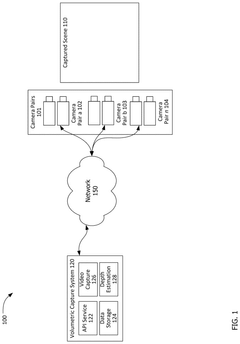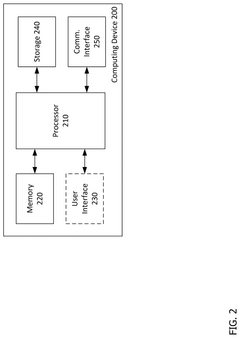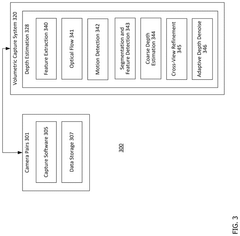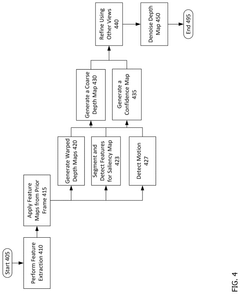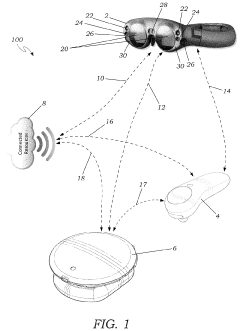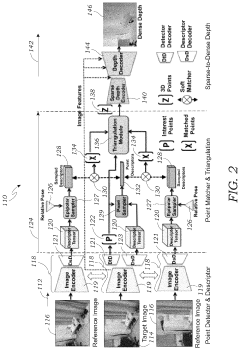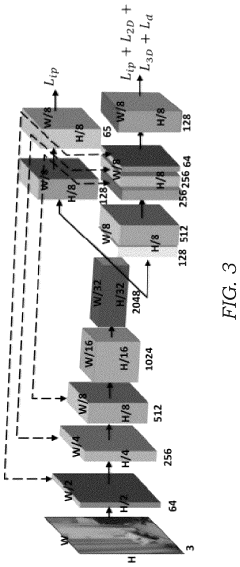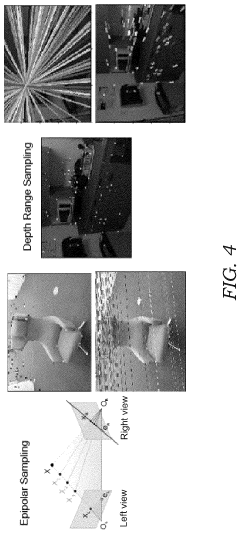Assessing Dolby Vision’s Algorithmic Developments for Depth Perception
JUL 30, 20259 MIN READ
Generate Your Research Report Instantly with AI Agent
Patsnap Eureka helps you evaluate technical feasibility & market potential.
Dolby Vision Evolution
Dolby Vision has undergone significant evolution since its inception, marking key milestones in the development of high dynamic range (HDR) imaging technology. Initially introduced in 2014, Dolby Vision aimed to enhance the visual experience by offering a wider color gamut, higher contrast ratios, and increased brightness levels compared to standard dynamic range (SDR) content.
The early iterations of Dolby Vision focused primarily on improving the overall picture quality through enhanced color and brightness capabilities. This phase saw the introduction of 12-bit color depth, allowing for a staggering 68 billion colors, far surpassing the 16.7 million colors possible with 8-bit systems. Additionally, Dolby Vision supported peak brightness levels of up to 10,000 nits, although most displays at the time could not fully utilize this capability.
As the technology matured, Dolby Vision expanded its focus to include more sophisticated metadata handling. This advancement allowed for dynamic scene-by-scene and even frame-by-frame optimization of content, ensuring that each image was displayed at its best possible quality on any compatible device. This dynamic metadata approach became a key differentiator for Dolby Vision in the HDR market.
The next significant leap in Dolby Vision's evolution came with the introduction of Dolby Vision IQ. This technology incorporated ambient light sensors in displays to automatically adjust picture settings based on the viewing environment. This adaptive approach ensured optimal viewing experiences in various lighting conditions, from bright daylight to dark rooms.
More recently, Dolby Vision has made strides in the realm of content creation and post-production. The introduction of Dolby Vision for Content Creators provided tools and workflows that allowed filmmakers and content producers to more easily create and master HDR content. This development has been crucial in increasing the availability of Dolby Vision content across various platforms and devices.
In the context of depth perception, Dolby Vision's algorithmic developments have focused on enhancing the perception of depth and dimensionality in 2D images. By leveraging its advanced color and brightness capabilities, Dolby Vision has worked to create more realistic and immersive visual experiences. These algorithms aim to enhance depth cues such as shadows, highlights, and color gradients, which contribute to the viewer's perception of three-dimensional space in a two-dimensional image.
The ongoing evolution of Dolby Vision continues to push the boundaries of visual technology, with recent efforts directed towards improving real-time processing capabilities and expanding compatibility across a wider range of devices and display technologies. As the technology progresses, it is likely to further refine its depth perception algorithms, potentially incorporating machine learning and AI to achieve even more sophisticated and lifelike visual representations.
The early iterations of Dolby Vision focused primarily on improving the overall picture quality through enhanced color and brightness capabilities. This phase saw the introduction of 12-bit color depth, allowing for a staggering 68 billion colors, far surpassing the 16.7 million colors possible with 8-bit systems. Additionally, Dolby Vision supported peak brightness levels of up to 10,000 nits, although most displays at the time could not fully utilize this capability.
As the technology matured, Dolby Vision expanded its focus to include more sophisticated metadata handling. This advancement allowed for dynamic scene-by-scene and even frame-by-frame optimization of content, ensuring that each image was displayed at its best possible quality on any compatible device. This dynamic metadata approach became a key differentiator for Dolby Vision in the HDR market.
The next significant leap in Dolby Vision's evolution came with the introduction of Dolby Vision IQ. This technology incorporated ambient light sensors in displays to automatically adjust picture settings based on the viewing environment. This adaptive approach ensured optimal viewing experiences in various lighting conditions, from bright daylight to dark rooms.
More recently, Dolby Vision has made strides in the realm of content creation and post-production. The introduction of Dolby Vision for Content Creators provided tools and workflows that allowed filmmakers and content producers to more easily create and master HDR content. This development has been crucial in increasing the availability of Dolby Vision content across various platforms and devices.
In the context of depth perception, Dolby Vision's algorithmic developments have focused on enhancing the perception of depth and dimensionality in 2D images. By leveraging its advanced color and brightness capabilities, Dolby Vision has worked to create more realistic and immersive visual experiences. These algorithms aim to enhance depth cues such as shadows, highlights, and color gradients, which contribute to the viewer's perception of three-dimensional space in a two-dimensional image.
The ongoing evolution of Dolby Vision continues to push the boundaries of visual technology, with recent efforts directed towards improving real-time processing capabilities and expanding compatibility across a wider range of devices and display technologies. As the technology progresses, it is likely to further refine its depth perception algorithms, potentially incorporating machine learning and AI to achieve even more sophisticated and lifelike visual representations.
Market Demand Analysis
The market demand for advanced depth perception technologies, particularly in the context of Dolby Vision's algorithmic developments, has been steadily growing across various industries. This surge in demand is primarily driven by the increasing need for immersive visual experiences in entertainment, automotive, and consumer electronics sectors.
In the entertainment industry, there is a significant push for more realistic and engaging content. Streaming platforms and content creators are constantly seeking ways to enhance viewer experience, making Dolby Vision's depth perception algorithms highly valuable. The global streaming market, which is expected to reach substantial growth in the coming years, is a key driver for this technology.
The automotive sector presents another substantial market for depth perception technologies. As autonomous and semi-autonomous vehicles become more prevalent, the need for accurate depth perception in various driving conditions has become crucial. Dolby Vision's algorithms could potentially enhance the safety and reliability of these systems, addressing a critical market need in the automotive industry.
Consumer electronics, particularly smartphones and tablets, represent a significant market for depth perception technologies. With the increasing popularity of augmented reality (AR) applications and advanced camera features, there is a growing demand for algorithms that can accurately perceive and render depth in real-time. This trend is likely to continue as consumers expect more sophisticated visual experiences from their devices.
The gaming industry is another sector showing strong demand for advanced depth perception technologies. As virtual reality (VR) and AR gaming experiences become more mainstream, the need for realistic depth rendering becomes paramount. Dolby Vision's algorithms could potentially enhance the immersion and realism in gaming environments, addressing a key market demand.
In the field of robotics and industrial automation, accurate depth perception is crucial for tasks such as object manipulation and navigation. The growing adoption of robots in manufacturing and logistics sectors indicates a potential market for advanced depth perception algorithms.
The healthcare industry also presents opportunities for depth perception technologies, particularly in medical imaging and surgical applications. Enhanced depth perception can lead to more accurate diagnoses and improved surgical outcomes, addressing critical needs in the healthcare sector.
While the market demand for advanced depth perception technologies is strong, it's important to note that competition in this space is intense. Several tech giants and startups are investing heavily in developing similar technologies. Therefore, Dolby Vision's success in capturing market share will depend on the unique advantages and applications of its algorithmic developments.
In the entertainment industry, there is a significant push for more realistic and engaging content. Streaming platforms and content creators are constantly seeking ways to enhance viewer experience, making Dolby Vision's depth perception algorithms highly valuable. The global streaming market, which is expected to reach substantial growth in the coming years, is a key driver for this technology.
The automotive sector presents another substantial market for depth perception technologies. As autonomous and semi-autonomous vehicles become more prevalent, the need for accurate depth perception in various driving conditions has become crucial. Dolby Vision's algorithms could potentially enhance the safety and reliability of these systems, addressing a critical market need in the automotive industry.
Consumer electronics, particularly smartphones and tablets, represent a significant market for depth perception technologies. With the increasing popularity of augmented reality (AR) applications and advanced camera features, there is a growing demand for algorithms that can accurately perceive and render depth in real-time. This trend is likely to continue as consumers expect more sophisticated visual experiences from their devices.
The gaming industry is another sector showing strong demand for advanced depth perception technologies. As virtual reality (VR) and AR gaming experiences become more mainstream, the need for realistic depth rendering becomes paramount. Dolby Vision's algorithms could potentially enhance the immersion and realism in gaming environments, addressing a key market demand.
In the field of robotics and industrial automation, accurate depth perception is crucial for tasks such as object manipulation and navigation. The growing adoption of robots in manufacturing and logistics sectors indicates a potential market for advanced depth perception algorithms.
The healthcare industry also presents opportunities for depth perception technologies, particularly in medical imaging and surgical applications. Enhanced depth perception can lead to more accurate diagnoses and improved surgical outcomes, addressing critical needs in the healthcare sector.
While the market demand for advanced depth perception technologies is strong, it's important to note that competition in this space is intense. Several tech giants and startups are investing heavily in developing similar technologies. Therefore, Dolby Vision's success in capturing market share will depend on the unique advantages and applications of its algorithmic developments.
Technical Challenges
Dolby Vision's algorithmic developments for depth perception face several significant technical challenges. The primary obstacle lies in accurately capturing and representing the complex three-dimensional structure of real-world scenes within a two-dimensional image or video format. This requires sophisticated algorithms capable of extracting depth information from visual cues such as occlusion, perspective, and texture gradients.
One of the key challenges is the need for real-time processing of high-resolution video streams. As Dolby Vision aims to enhance the viewing experience in both cinema and home entertainment systems, the algorithms must be capable of processing 4K or even 8K video content at frame rates of 60 fps or higher. This demands substantial computational power and highly optimized algorithms to maintain low latency and smooth playback.
Another significant hurdle is the accurate estimation of depth in scenes with complex lighting conditions, reflective surfaces, or transparent objects. These scenarios can confuse traditional depth estimation algorithms, leading to artifacts or inconsistencies in the perceived depth. Dolby Vision must develop robust algorithms that can handle a wide range of lighting conditions and material properties to ensure consistent depth perception across diverse content.
The challenge of maintaining temporal consistency in depth estimation across consecutive frames is also crucial. Flickering or sudden changes in perceived depth can be highly distracting to viewers and diminish the overall visual experience. Developing algorithms that can smoothly track and update depth information while accounting for camera and object motion is a complex task that requires sophisticated temporal filtering and prediction techniques.
Furthermore, the integration of depth perception algorithms with existing color grading and HDR processing pipelines presents its own set of challenges. Ensuring that depth enhancement does not interfere with the artistic intent of content creators or introduce unwanted artifacts in the final image requires careful calibration and fine-tuning of the entire processing chain.
Lastly, the development of efficient compression and transmission techniques for depth-enhanced content is a critical challenge. As depth information adds an additional layer of data to already bandwidth-intensive video streams, Dolby Vision must innovate in compression algorithms to minimize the impact on file sizes and streaming bitrates while preserving the quality of depth perception.
One of the key challenges is the need for real-time processing of high-resolution video streams. As Dolby Vision aims to enhance the viewing experience in both cinema and home entertainment systems, the algorithms must be capable of processing 4K or even 8K video content at frame rates of 60 fps or higher. This demands substantial computational power and highly optimized algorithms to maintain low latency and smooth playback.
Another significant hurdle is the accurate estimation of depth in scenes with complex lighting conditions, reflective surfaces, or transparent objects. These scenarios can confuse traditional depth estimation algorithms, leading to artifacts or inconsistencies in the perceived depth. Dolby Vision must develop robust algorithms that can handle a wide range of lighting conditions and material properties to ensure consistent depth perception across diverse content.
The challenge of maintaining temporal consistency in depth estimation across consecutive frames is also crucial. Flickering or sudden changes in perceived depth can be highly distracting to viewers and diminish the overall visual experience. Developing algorithms that can smoothly track and update depth information while accounting for camera and object motion is a complex task that requires sophisticated temporal filtering and prediction techniques.
Furthermore, the integration of depth perception algorithms with existing color grading and HDR processing pipelines presents its own set of challenges. Ensuring that depth enhancement does not interfere with the artistic intent of content creators or introduce unwanted artifacts in the final image requires careful calibration and fine-tuning of the entire processing chain.
Lastly, the development of efficient compression and transmission techniques for depth-enhanced content is a critical challenge. As depth information adds an additional layer of data to already bandwidth-intensive video streams, Dolby Vision must innovate in compression algorithms to minimize the impact on file sizes and streaming bitrates while preserving the quality of depth perception.
Current Dolby Solutions
01 Enhanced depth perception in Dolby Vision displays
Dolby Vision technology incorporates advanced depth perception techniques to enhance the viewing experience. This includes methods for improving contrast, color accuracy, and dynamic range to create a more immersive 3D-like effect without the need for special glasses. The technology utilizes sophisticated algorithms to analyze and adjust image data in real-time, resulting in a more realistic and engaging visual experience.- Enhanced depth perception in Dolby Vision displays: Dolby Vision technology incorporates advanced depth perception techniques to enhance the viewing experience. This includes methods for improving stereoscopic imaging, adjusting brightness and contrast dynamically, and optimizing color reproduction to create a more immersive 3D-like effect on 2D displays.
- Image processing for depth enhancement: Various image processing techniques are employed to enhance depth perception in Dolby Vision systems. These may include edge detection, object segmentation, and depth map generation algorithms that analyze and manipulate visual data to create a stronger sense of depth and dimensionality in the displayed content.
- Integration of eye-tracking and head-tracking technologies: Dolby Vision systems may incorporate eye-tracking and head-tracking technologies to adjust the displayed image based on the viewer's position and gaze. This allows for a more personalized and responsive depth perception experience, adapting the visual output to the individual viewer's perspective.
- High dynamic range (HDR) and wide color gamut for improved depth cues: Dolby Vision leverages high dynamic range and wide color gamut capabilities to provide more accurate and nuanced depth cues. By offering a broader range of brightness levels and colors, the technology can better represent the subtle gradations and shadows that contribute to depth perception in natural scenes.
- Multi-layer display technology for enhanced depth: Some Dolby Vision implementations may utilize multi-layer display technology to create physical depth in the display itself. This approach involves stacking multiple LCD or OLED panels to produce a genuine sense of depth and parallax, enhancing the overall 3D effect without the need for special glasses or other viewing aids.
02 Integration of depth sensors with Dolby Vision
Combining depth sensors with Dolby Vision technology allows for more accurate depth mapping and enhanced 3D effects. These systems can capture real-time depth information and use it to adjust the display output, creating a more realistic sense of depth and space. This integration is particularly useful in applications such as augmented reality, virtual reality, and advanced gaming experiences.Expand Specific Solutions03 Dolby Vision in head-mounted displays
Implementing Dolby Vision technology in head-mounted displays (HMDs) for virtual and augmented reality applications enhances depth perception and overall visual quality. This adaptation of Dolby Vision takes into account the unique viewing conditions of HMDs, including the close proximity of the display to the eyes and the need for low latency in image processing.Expand Specific Solutions04 AI-enhanced depth perception for Dolby Vision
Artificial intelligence and machine learning algorithms are being employed to further enhance depth perception in Dolby Vision systems. These AI-driven approaches can analyze scene content, predict depth information, and optimize display parameters in real-time, resulting in more accurate and natural-looking depth effects across various types of content.Expand Specific Solutions05 Dolby Vision depth perception in automotive displays
Adapting Dolby Vision technology for automotive displays presents unique challenges and opportunities for enhancing depth perception. This application focuses on improving driver awareness and safety by providing clearer, more depth-rich visual information on in-vehicle displays. The technology takes into account factors such as varying lighting conditions and the need for quick visual processing by drivers.Expand Specific Solutions
Key Industry Players
The development of Dolby Vision's algorithmic advancements for depth perception is currently in a competitive and rapidly evolving phase. The market is experiencing significant growth, driven by increasing demand for enhanced visual experiences across various industries. While the technology is maturing, it's not yet fully mature, with key players like Dolby Laboratories, Samsung Electronics, and Sony Group leading innovation. Companies such as Huawei, NXP Semiconductors, and Koninklijke Philips are also making notable contributions, indicating a diverse and dynamic competitive landscape. The involvement of research institutions like Tianjin University and Xiamen University suggests ongoing academic collaboration, potentially accelerating technological progress in this field.
Dolby Laboratories Licensing Corp.
Technical Solution: Dolby Vision's algorithmic developments for depth perception focus on enhancing High Dynamic Range (HDR) content with precise depth information. The technology utilizes advanced machine learning algorithms to analyze each frame and create a depth map, which is then used to optimize the rendering of 3D scenes[1]. Dolby Vision IQ, an extension of this technology, adapts the content based on the viewing environment, adjusting brightness and contrast to maintain depth perception in various lighting conditions[2]. The system also incorporates real-time tone mapping to ensure consistent depth representation across different display capabilities[3].
Strengths: Industry-leading HDR technology, wide adoption in consumer electronics, adaptive viewing experience. Weaknesses: Requires specialized hardware for full implementation, potential licensing costs for manufacturers.
Samsung Electronics Co., Ltd.
Technical Solution: Samsung's approach to depth perception in display technologies centers around their Neo QLED and Micro LED displays. These utilize AI-powered quantum processors to enhance depth and dimensionality in images. The company's Object Depth Enhancer technology uses AI to identify and process objects separately from their backgrounds, creating a greater sense of three-dimensionality[6]. Samsung also employs Multi-Intelligence AI upscaling, which includes depth enhancement as one of its key features, analyzing low-resolution content to add depth information and improve overall picture quality[7].
Strengths: Wide range of display technologies, strong AI integration, broad market presence. Weaknesses: Proprietary technologies may limit compatibility with other systems.
Core Dolby Innovations
Real-time, high-quailty, and spatiotemporally consistent depth estimation from two-dimensional, color images
PatentPendingUS20250173883A1
Innovation
- The proposed system employs a deep learning-based stereo-matching depth estimation model that includes a Convolutional Neural Network (CNN) for feature extraction, an attention mechanism for enhanced feature matching, and a hierarchical model structure for reduced computational overhead and improved accuracy. This system generates dense depth data for every pixel in multiple image pairs at high frame rates, optimizing the volumetric capture process.
Systems and methods for depth estimation by learning triangulation and densification of sparse points for multi-view stereo
PatentActiveUS11948320B2
Innovation
- The method involves estimating depths from multi-view images using a shared RGB encoder and descriptor decoder, which outputs descriptors, detects interest points, and triangulates them using singular value decomposition to generate 3D points, followed by a sparse depth encoder and depth decoder to produce a dense depth image, reducing reliance on costly active sensors and improving computational efficiency.
Standardization Efforts
Standardization efforts for Dolby Vision's depth perception algorithms have been gaining momentum in recent years, as the industry recognizes the importance of establishing common frameworks for immersive visual experiences. These efforts aim to create a unified approach to implementing and evaluating depth perception technologies across various platforms and devices.
One of the primary standardization initiatives focuses on the development of consistent metadata formats for depth information. This includes defining standardized ways to encode, transmit, and interpret depth maps alongside traditional video content. By establishing these standards, content creators and device manufacturers can ensure seamless interoperability and optimal viewing experiences across different display technologies.
Another key area of standardization involves the creation of reference models for depth estimation algorithms. These models serve as benchmarks for evaluating the performance and accuracy of different depth perception techniques. By providing a common set of test scenarios and evaluation metrics, the industry can more effectively compare and improve upon existing algorithms.
Efforts are also underway to standardize the integration of depth perception technologies with other emerging visual standards, such as High Dynamic Range (HDR) and Wide Color Gamut (WCG). This holistic approach aims to create a comprehensive framework for next-generation visual experiences that seamlessly combine enhanced contrast, color, and depth perception.
Collaboration between industry leaders, including Dolby Laboratories, and standards organizations like the International Telecommunication Union (ITU) and the Society of Motion Picture and Television Engineers (SMPTE) has been crucial in driving these standardization efforts forward. These partnerships have resulted in the development of technical specifications and guidelines that address various aspects of depth perception implementation.
One significant outcome of these collaborations has been the establishment of standardized testing methodologies for assessing the quality and accuracy of depth perception algorithms. These methodologies include defined sets of test content, viewing conditions, and evaluation criteria, enabling more consistent and comparable results across different implementations.
As standardization efforts continue to evolve, there is a growing focus on addressing the challenges of real-time depth perception in live broadcast scenarios. This includes developing standards for low-latency depth map generation and transmission, as well as guidelines for integrating depth perception technologies into existing broadcast workflows.
One of the primary standardization initiatives focuses on the development of consistent metadata formats for depth information. This includes defining standardized ways to encode, transmit, and interpret depth maps alongside traditional video content. By establishing these standards, content creators and device manufacturers can ensure seamless interoperability and optimal viewing experiences across different display technologies.
Another key area of standardization involves the creation of reference models for depth estimation algorithms. These models serve as benchmarks for evaluating the performance and accuracy of different depth perception techniques. By providing a common set of test scenarios and evaluation metrics, the industry can more effectively compare and improve upon existing algorithms.
Efforts are also underway to standardize the integration of depth perception technologies with other emerging visual standards, such as High Dynamic Range (HDR) and Wide Color Gamut (WCG). This holistic approach aims to create a comprehensive framework for next-generation visual experiences that seamlessly combine enhanced contrast, color, and depth perception.
Collaboration between industry leaders, including Dolby Laboratories, and standards organizations like the International Telecommunication Union (ITU) and the Society of Motion Picture and Television Engineers (SMPTE) has been crucial in driving these standardization efforts forward. These partnerships have resulted in the development of technical specifications and guidelines that address various aspects of depth perception implementation.
One significant outcome of these collaborations has been the establishment of standardized testing methodologies for assessing the quality and accuracy of depth perception algorithms. These methodologies include defined sets of test content, viewing conditions, and evaluation criteria, enabling more consistent and comparable results across different implementations.
As standardization efforts continue to evolve, there is a growing focus on addressing the challenges of real-time depth perception in live broadcast scenarios. This includes developing standards for low-latency depth map generation and transmission, as well as guidelines for integrating depth perception technologies into existing broadcast workflows.
Content Creation Impact
Dolby Vision's algorithmic developments for depth perception have significantly impacted content creation processes across various media industries. The introduction of advanced depth perception algorithms has revolutionized the way filmmakers, game developers, and virtual reality content creators approach their craft.
In the film industry, Dolby Vision's depth perception technology has enabled cinematographers to capture and manipulate scenes with unprecedented precision. This has led to more immersive and visually stunning productions, as filmmakers can now fine-tune the depth of field and create more realistic three-dimensional environments. The technology has also streamlined post-production workflows, allowing for more efficient color grading and visual effects integration.
For game developers, Dolby Vision's algorithms have opened up new possibilities in creating lifelike virtual worlds. The enhanced depth perception capabilities have improved the overall gaming experience by providing more accurate spatial awareness and realistic lighting effects. This has resulted in games with more engaging environments and improved player immersion, particularly in virtual reality and augmented reality applications.
In the realm of virtual reality, content creators have leveraged Dolby Vision's depth perception algorithms to overcome longstanding challenges in creating convincing 3D environments. The technology has enabled more precise object placement and improved depth cues, reducing motion sickness and enhancing the overall user experience. This has accelerated the adoption of VR technology across various industries, from entertainment to education and training simulations.
The impact on content creation extends beyond visual media to audio production as well. Dolby Vision's depth perception algorithms have been integrated with spatial audio technologies, allowing for more accurate sound placement in three-dimensional space. This synergy between visual and auditory depth perception has resulted in more immersive and realistic multimedia experiences across various platforms.
Furthermore, the technology has influenced the way content is distributed and consumed. With the increasing prevalence of HDR-capable displays and devices, content creators can now deliver their vision with greater fidelity to the end-user. This has raised the bar for visual quality across the industry, prompting content creators to push the boundaries of what is possible in terms of depth and realism in their productions.
As Dolby Vision's algorithmic developments continue to evolve, they are likely to further transform content creation processes. The technology is poised to enable new forms of interactive and immersive media, blurring the lines between traditional and emerging content formats. This ongoing innovation in depth perception algorithms will undoubtedly continue to shape the future of content creation across various media industries.
In the film industry, Dolby Vision's depth perception technology has enabled cinematographers to capture and manipulate scenes with unprecedented precision. This has led to more immersive and visually stunning productions, as filmmakers can now fine-tune the depth of field and create more realistic three-dimensional environments. The technology has also streamlined post-production workflows, allowing for more efficient color grading and visual effects integration.
For game developers, Dolby Vision's algorithms have opened up new possibilities in creating lifelike virtual worlds. The enhanced depth perception capabilities have improved the overall gaming experience by providing more accurate spatial awareness and realistic lighting effects. This has resulted in games with more engaging environments and improved player immersion, particularly in virtual reality and augmented reality applications.
In the realm of virtual reality, content creators have leveraged Dolby Vision's depth perception algorithms to overcome longstanding challenges in creating convincing 3D environments. The technology has enabled more precise object placement and improved depth cues, reducing motion sickness and enhancing the overall user experience. This has accelerated the adoption of VR technology across various industries, from entertainment to education and training simulations.
The impact on content creation extends beyond visual media to audio production as well. Dolby Vision's depth perception algorithms have been integrated with spatial audio technologies, allowing for more accurate sound placement in three-dimensional space. This synergy between visual and auditory depth perception has resulted in more immersive and realistic multimedia experiences across various platforms.
Furthermore, the technology has influenced the way content is distributed and consumed. With the increasing prevalence of HDR-capable displays and devices, content creators can now deliver their vision with greater fidelity to the end-user. This has raised the bar for visual quality across the industry, prompting content creators to push the boundaries of what is possible in terms of depth and realism in their productions.
As Dolby Vision's algorithmic developments continue to evolve, they are likely to further transform content creation processes. The technology is poised to enable new forms of interactive and immersive media, blurring the lines between traditional and emerging content formats. This ongoing innovation in depth perception algorithms will undoubtedly continue to shape the future of content creation across various media industries.
Unlock deeper insights with Patsnap Eureka Quick Research — get a full tech report to explore trends and direct your research. Try now!
Generate Your Research Report Instantly with AI Agent
Supercharge your innovation with Patsnap Eureka AI Agent Platform!
